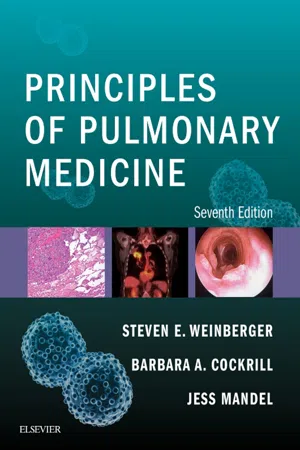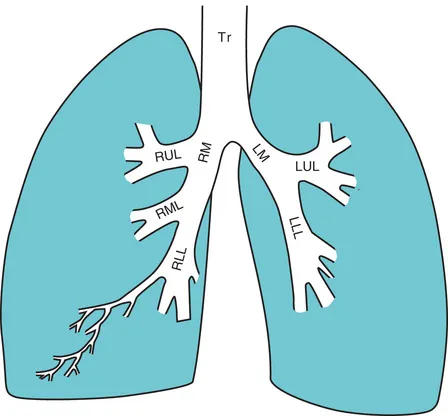
Principles of Pulmonary Medicine E-Book
- 416 pages
- English
- ePUB (mobile friendly)
- Available on iOS & Android
Principles of Pulmonary Medicine E-Book
About this book
With an emphasis on the pathophysiologic basis of pulmonary disease, Principles of Pulmonary Medicine, 7th Edition, by Drs. Steven E Weinberger, Barbara A Cockrill, and Jess Mandel, provides a superbly illustrated introduction to this fast-changing field. This essential text employs a concise and understandable approach, integrating clinical topics with underlying physiologic, pathophysiologic, and basic science concepts critical for medical students, trainees, and those looking for a practical update on both acute and chronic pulmonary diseases- Covers all that's new in the field, including new CT lung cancer screening guidelines; new concepts in the pathogenesis of asthma, interstitial lung disease, and other pulmonary diseases; and evolving therapies for idiopathic pulmonary fibrosis, pulmonary hypertension, and advanced lung cancer.- Features updated information on the expanded use of advanced interventional pulmonology (bronchoscopic) procedures, improvements in precision treatment of lung tumors based on genetic profiles, and new and emerging infections with respiratory involvement.- Covers hot topics such as lung tumor treatment, including use of genetic markers and immunotherapy; lung cancer screening reflecting the latest guidelines on who, how, and when to screen; and newer bronchoscopic procedures, such as navigational bronchoscopy.- Expert Consult™ eBook version included with purchase. This enhanced eBook experience allows you to search all of the text, figures, and references from the book on a variety of devices.
Frequently asked questions
- Essential is ideal for learners and professionals who enjoy exploring a wide range of subjects. Access the Essential Library with 800,000+ trusted titles and best-sellers across business, personal growth, and the humanities. Includes unlimited reading time and Standard Read Aloud voice.
- Complete: Perfect for advanced learners and researchers needing full, unrestricted access. Unlock 1.4M+ books across hundreds of subjects, including academic and specialized titles. The Complete Plan also includes advanced features like Premium Read Aloud and Research Assistant.
Please note we cannot support devices running on iOS 13 and Android 7 or earlier. Learn more about using the app.
Information
Pulmonary Anatomy and Physiology
The Basics
Abstract
Keywords
Anatomy

Physiology
Mechanical Aspects of the Lungs and Chest Wall
Table of contents
- Cover image
- Title Page
- Table of Contents
- Copyright
- Dedication
- Introduction to the Seventh Edition
- 1 Pulmonary Anatomy and Physiology
- 2 Presentation of the Patient with Pulmonary Disease
- 3 Evaluation of the Patient With Pulmonary Disease
- 4 Anatomic and Physiologic Aspects of Airways
- 5 Asthma
- 6 Chronic Obstructive Pulmonary Disease
- 7 Miscellaneous Airway Diseases
- 8 Anatomic and Physiologic Aspects of the Pulmonary Parenchyma
- 9 Overview of Diffuse Parenchymal Lung Diseases
- 10 Diffuse Parenchymal Lung Diseases Associated With Known Etiologic Agents
- 11 Diffuse Parenchymal Lung Diseases of Unknown Etiology
- 12 Anatomic and Physiologic Aspects of the Pulmonary Vasculature
- 13 Pulmonary Embolism
- 14 Pulmonary Hypertension
- 15 Pleural Disease
- 16 Mediastinal Disease
- 17 Anatomic and Physiologic Aspects of Neural, Muscular, and Chest Wall Interactions with the Lungs
- 18 Disorders of Ventilatory Control
- 19 Disorders of the Respiratory Pump
- 20 Lung Cancer
- 21 Lung Cancer
- 22 Lung Defense Mechanisms
- 23 Pneumonia
- 24 Tuberculosis and Nontuberculous Mycobacteria
- 25 Miscellaneous Infections Caused by Fungi and Pneumocystis
- 26 Pulmonary Complications in the Immunocompromised Host
- 27 Classification and Pathophysiologic Aspects of Respiratory Failure
- 28 Acute Respiratory Distress Syndrome
- 29 Management of Respiratory Failure
- A Sample Problems Using Respiratory Equations
- B Pulmonary Function Tests: Guidelines for Interpretation and Sample Problems
- C Arterial Blood Gases: Guidelines for Interpretation and Sample Problems
- Index